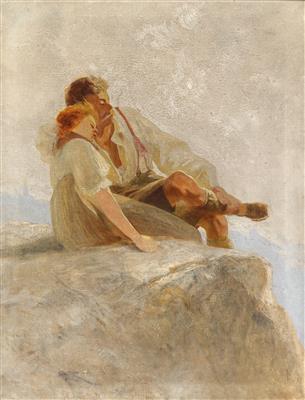Karl Wilhelm Diefenbach

(Hadamar 1851-1913 Capri)
Maja with a Friend (on the Kampenwand), 1889, oil on canvas, 88 x 67 cm, framed, (Rei)
Provenance:
Purchased directly from the artist, by inheritance to the current owner;
Private Collection Germany.
We are grateful to Dr. Claudia Wagner for confirming the authenticity on the basis of a high-resolution photograph.
Karl Wilhelm Diefenbach was probably one of the most eccentric artists of the late 19th and early 20th centuries. Born in 1851 in the small town of Hademar, the painter studied at the Munich Academy of Fine Arts from 1872 and caused a great stir in the Munich area from the 1880s. Typhoid caused him to give up alcohol and tobacco and subsequently also the consumption of meat. This made him a crank at the time and earned him the unflattering name "Kohlrabi Apostle". Early on, the barefoot vegetarian dressed in a smock promoted free love relationships and nudity.
In 1885, he founded his first commune in the Höllriegelskreuth quarry in Bavaria. There, disputes arose with the authorities and, due to the commune members’ nude sunbathing, Germany’s first nudist trial.
His precarious financial situation prompted Diefenbach to accept the invitation of the Österreichischer Kunstverein and go to Vienna. The exhibition ended in a fiasco for him, as the Kunstverein embezzled funds. The conflict drove him to the edge and Diefenbach had to declare himself homeless. Nevertheless, he remained in Vienna and founded the country commune of “Himmelhof” in Ober-St.-Veit in 1897. The provocative and authoritarian manner with which Diefenbach ruled over the members of his community led to tensions and the commune went bankrupt in 1899. Ultimately, after a brief stay in Trieste, the artist ended up on the island of Capri. There he remained until the end of his life, without achieving his longed-for artistic breakthrough.
The present lot was probably created in the summer of 1889 in the course of Karl Wilhelm Diefenbach’s stay in Traunstein or Aschau, where he made excursions to the Kampenwand. He was accompanied on these excursions by his long-time acquaintance and then lover Maximiliane Schlotthauer, called Maja, as well as his friend Georg Sinner, landowner at Rheinburg Castle in Baden. It is most likely those two who he portrayed in the present lot. He also had this picture on display in his studio, as a photograph attests. (JP)
Expert: Mag. Dimitra Reimüller
 Mag. Dimitra Reimüller
Mag. Dimitra Reimüller
+43-1-515 60-355
19c.paintings@dorotheum.at
06.05.2021 - 15:38
- Odhadní cena:
-
EUR 2.600,- do EUR 3.000,-
- Vyvolávací cena:
-
EUR 2.600,-
Karl Wilhelm Diefenbach
(Hadamar 1851-1913 Capri)
Maja with a Friend (on the Kampenwand), 1889, oil on canvas, 88 x 67 cm, framed, (Rei)
Provenance:
Purchased directly from the artist, by inheritance to the current owner;
Private Collection Germany.
We are grateful to Dr. Claudia Wagner for confirming the authenticity on the basis of a high-resolution photograph.
Karl Wilhelm Diefenbach was probably one of the most eccentric artists of the late 19th and early 20th centuries. Born in 1851 in the small town of Hademar, the painter studied at the Munich Academy of Fine Arts from 1872 and caused a great stir in the Munich area from the 1880s. Typhoid caused him to give up alcohol and tobacco and subsequently also the consumption of meat. This made him a crank at the time and earned him the unflattering name "Kohlrabi Apostle". Early on, the barefoot vegetarian dressed in a smock promoted free love relationships and nudity.
In 1885, he founded his first commune in the Höllriegelskreuth quarry in Bavaria. There, disputes arose with the authorities and, due to the commune members’ nude sunbathing, Germany’s first nudist trial.
His precarious financial situation prompted Diefenbach to accept the invitation of the Österreichischer Kunstverein and go to Vienna. The exhibition ended in a fiasco for him, as the Kunstverein embezzled funds. The conflict drove him to the edge and Diefenbach had to declare himself homeless. Nevertheless, he remained in Vienna and founded the country commune of “Himmelhof” in Ober-St.-Veit in 1897. The provocative and authoritarian manner with which Diefenbach ruled over the members of his community led to tensions and the commune went bankrupt in 1899. Ultimately, after a brief stay in Trieste, the artist ended up on the island of Capri. There he remained until the end of his life, without achieving his longed-for artistic breakthrough.
The present lot was probably created in the summer of 1889 in the course of Karl Wilhelm Diefenbach’s stay in Traunstein or Aschau, where he made excursions to the Kampenwand. He was accompanied on these excursions by his long-time acquaintance and then lover Maximiliane Schlotthauer, called Maja, as well as his friend Georg Sinner, landowner at Rheinburg Castle in Baden. It is most likely those two who he portrayed in the present lot. He also had this picture on display in his studio, as a photograph attests. (JP)
Expert: Mag. Dimitra Reimüller
 Mag. Dimitra Reimüller
Mag. Dimitra Reimüller
+43-1-515 60-355
19c.paintings@dorotheum.at
|
Horká linka kupujících
Po-Pá: 10.00 - 17.00
kundendienst@dorotheum.at +43 1 515 60 200 |
| Aukce: | Obrazy 19. století |
| Typ aukce: | Online aukce |
| Datum: | 06.05.2021 - 15:38 |
| Místo konání aukce: | Wien | Palais Dorotheum |
| Prohlídka: | 03.05. - 06.05.2021 |
Všechny objekty umělce
